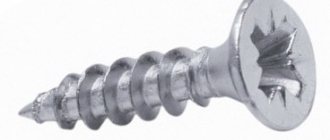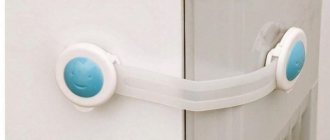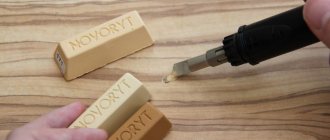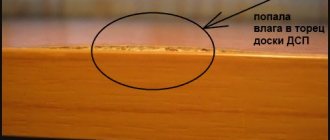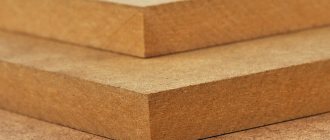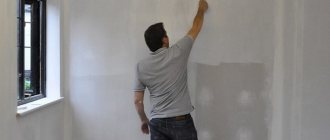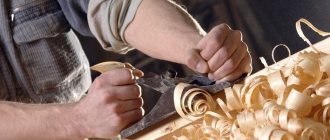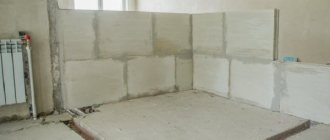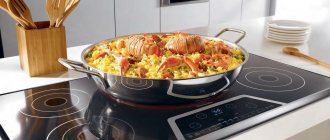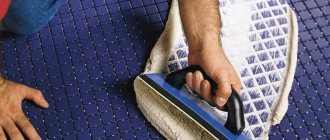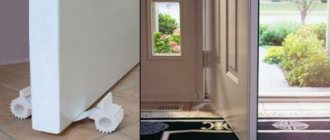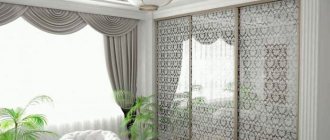Chipboard sheet is a good material for creating the shape of a product, but it is many times inferior to natural wood in appearance.
This material is very sensitive to the influence of atmospheric factors. Chipboard structures are coated with protective agents at the production stage.
However, if such products are subject to frequent mechanical stress, then such protection will not last long, therefore this requires additional application of special impregnations.
We will answer the questions of how and with what to coat this type of material in this article.
Content
Even at the very beginning of production, sawdust and shavings, after drying, are impregnated with formaldehyde resins. After pressing, the surface of the boards is laminated, sometimes even varnished.
But protecting the surface does not prevent the penetration of moisture from the ends through which it enters. Accumulating inside, water gradually begins to penetrate the wood fibers, which leads to the destruction of the slab. Consequently, the ends must first be saved from liquid penetration during operation.
If they are tightly sealed, the service life of the slabs will be much longer.
The photo shows the effects of water on a chipboard countertop.
Why are the ends the starting point for destruction? Yes, because the production of slabs of the required standard sizes, as well as the preparation of pieces of material of different sizes, requires cutting. In this case, the integrity of the wood fibers is compromised.
Thus, chipboard protection from moisture is carried out in three directions:
- impregnation of wood fibers with resins;
- special surface treatment;
- end sealing.
Necessary tools and materials
To cover the slab with your own hands, you can use various decorative elements that differ in quality and material of production, appearance, and also cost. The choice will depend on the preferences and financial abilities of the owner. But at home, two types of decorative stripes are most often used.
- Melamine edge is a more common and economical option. It is used for processing cheap products and furniture structures. The main advantage of this material is the ease of gluing and affordable cost. Among the shortcomings, only a short service life can be noted, because melamine is rapidly destroyed by water or mechanical damage. Therefore, it is not recommended to stick it on furniture structures in children's rooms or kitchens. Melamine tape is ideal for hallways, corridors, and when assembling auxiliary structures, such as shelves or mezzanines.
Surface treatment of plates
The front and back surfaces of the slab, as the largest contact areas, without any protection, can pass through and absorb, accordingly, the largest amount of liquid. It would be a good idea to cover these surfaces with something moisture-proof. Some of the methods of such coating are possible only in factory conditions, some are also possible at home.
One of the main methods of protection is lamination. In this case, a melamine film is laid on sanded chipboard at high pressure and high temperature. The essence of this process is not pressing, but the fact that under these conditions the film polymerizes the surface of the slab, becoming one with it.
There is another method that is performed in the factory - laminating. Pressure and heat are also used here, but more gentle. The already hardened film is pressed against the glue-coated slab. If lamination is a chemical process, then laminating is a mechanical process.
Components of laminated chipboard
At home, non-laminated chipboard is often coated with several layers of paint for protection. Before painting, pre-treat the surface:
- dust is carefully swept away and washed off the surface;
- for the first time, the plate is coated with hot drying oil;
- then this is done with cold drying oil until an outer crust forms;
- the top is painted. With any painting method, you must remember that each subsequent layer of paint is applied to the already dried previous one.
There are several other ways to protect yourself from getting wet. For example, a surface that will not be subject to mechanical stress can be protected as follows: rub it with stearin, then heat it with a hairdryer. Let cool and repeat this a couple more times. Or: one part of bitumen varnish is mixed with five parts of drying oil. Coating is carried out twice.
Edge processing of furniture parts. Chipboard edging. Edging with PVC edges.
Furniture edging is an essential finishing element of any furniture piece. Edging chipboard is the most important step in the manufacture of furniture, because... The edge performs not only an aesthetic function, but also a protective one: the presence of a furniture edge prevents unwanted moisture absorption, drying out and mechanical damage to the furniture. Its purpose is also to protect the environment from formaldehyde, which has a negative effect on the human body.
Edging laminated chipboard furniture
Despite the imperfect environmental friendliness, furniture made from laminated chipboard has gained wide popularity in the production of office, kitchen and cabinet furniture due to its low cost and attractive appearance. But such furniture becomes usable only after finishing the edges.
- Formaldehyde resins are used to glue individual elements of furniture made from chipboard, so the processing of furniture edges on parts made from chipboard is a mandatory process in the production of such furniture.
- Like any furniture made from laminated chipboard, it can also get damaged during use. In order for the furniture to have a finished look and meet all requirements, furniture edges of different types are used.
Chipboard edge processing. PVC edging.
Chipboards are used quite often in furniture production. Despite the fact that chipboard is easy to process, the edges of the furniture parts must be additionally finished.
- The edges of edged chipboard look ugly and, without finishing, significantly spoil the overall appearance of the entire product.
- Moisture enters through the untreated edge, the negative impact of which leads to swelling of the slab and loss of its presentation.
Processing of chipboard edges is most often carried out with edging tape or PVC edge. If the furniture tape used is of high quality and matched to the tone of the furniture, then the processing of PVC edges is practically invisible.
How to process the edges of furniture parts
PVC adhesive edge is one of the most affordable ways to finish furniture elements. A variety of textures and colors of furniture tape can not only camouflage the edges of furniture, but also advantageously emphasize its contours, shading the curves with a contrasting shade. In addition, there are differences in surface type; designers use this feature in their projects.
Furniture tape can be:
- smooth,
- rough,
- embossed like wood,
- color.
Smooth options are most often used in furniture production, because... they do not limit the functionality of the furniture and are ideally combined with the main body of the product. The thickness of the PVC edge can vary between 0.4-3.0 mm.
The main advantage of using edge tape is its elasticity; it does not break and sticks firmly to the surface being treated. However, in order to produce high-quality edge gluing, it is necessary to use specialized equipment.
We provide edge processing services for furniture made of laminated chipboard and chipboard at affordable prices. Our company has the necessary German and Italian-made equipment for high-quality application of PVC edges. Experienced specialists will complete your order quickly and accurately.
How to treat plywood, chipboard and wood to protect against moisture?
The most susceptible to moisture are the sink, cabinet with dryer, countertop, and furniture near and above the stove.
The taps all start to leak at some point. So, the most potentially dangerous place in the sink is where the faucet crashes into the countertop. This is the point of contact between metal and wood. It is possible not only for the faucet to leak, but also for water to condense at the contact point. Therefore, this place is cleaned and dried with a hairdryer. Next, a layer of PVA glue is applied, after which it dries - silicone. You can use construction sealant, this is also a silicone mass; it even seals window frames against leaks.
The edge not only protects the chipboard from moisture, but also reduces emissions of harmful substances
In the dish cabinet, you should check the presence or absence of a tray: if it is not there, the liquid, flowing to the bottom of the cabinet, will ruin it. For all kitchen furniture where it is possible to get wet, you need to make it a rule: degrease this area and then do not skimp on the sealant.
To seal the seams, it is better to use sanitary silicone of a suitable shade: dark mold spots will not appear on the surface.
Non-laminated edges of the tabletop are covered with connecting or end strips. They come in metal or plastic. The protection is not so great, so the end of the tabletop should first be treated with silicone. Another method of protection is to apply furniture varnish or PVA glue to the cut area. Self-adhesive films or tape offered by the construction market cannot be called reliable protection.
We use solutions
Chipboard is trimmed very often, since in production it is made in sheets of a certain length. Many types of different products are subsequently made from them, ranging from ordinary partitions to complex furniture. This material is often coated (laminated) with special paint.
The end can be treated with several substances:
- 1. Waterproof glue. This is done primarily to protect it from moisture.
- 2. Special sealants. These substances have the same purpose as the previous type.
- 3. Paint. If you need to give the product a beautiful look, then the end can be coated with any paint, matching it to the color of the item.
Sealing chipboard joints on the floor
The difficulty lies in the fact that the slabs on the floor are constantly subjected to significant physical stress; they “play” relative to each other. For this reason, the putty does not want to stick. There are several popular ways to seal such seams.
The seams are covered with epoxy mixed with sawdust. The sawdust is first finely sifted. The composition sets very quickly, so it is not worth preparing a large volume of such putty at once. Such protection serves for a long time and reliably. But the price of epoxy is high, and sealing joints is expensive.
You can replace the epoxy with hot wood glue. You need to mix sawdust in it and go through the seams.
The effect is achieved even greater than with epoxy, since the hot glue penetrates deep inside. This method also saves from moisture, and the joint stops “playing”. True, it is advisable not to walk on such a floor for several days, since wood glue takes a long time to dry.
This method is much cheaper. And if the floor is covered with linoleum on top, then you can completely forget about damage to the chipboards.
You might be interested to know
How can you protect chipboard panels from moisture?
1. Treating chipboard with drying oil
One of the simplest methods is applying drying oil to a chipboard. Most often, this method is used when the particle board is planned to be laid on the floor when creating a rough screed. Drying oil is applied to the main part of the slabs in two layers. Drying oil should be applied to the ends of chipboard boards at least three times, since in these areas it will be absorbed especially intensively.
To increase the moisture resistance of chipboard panels, you can add a little bitumen varnish to the drying oil. 1 part varnish to 5 parts drying oil is enough.
2. Painting chipboards with PVA glue
It will be possible to increase the waterproof performance of the particle board if you coat it with PVA glue. This method is used in almost any situation. That is, a slab treated in this way can be used to level surfaces and install partitions. But you can start work only after the glue has completely dried.
All about edging laminated chipboards
- What is it anyway and why is it necessary?
- Necessary tools and materials
- How to glue the edge?
- Melamine
- PVC
- Adviсe
Laminated chipboard composite material is made by pressing small particles of wood mixed with a special non-mineral glue. The material is cheap and excellent for assembling furniture. The main disadvantage of laminated chipboard is that its end parts are not processed, so in cross-section they sharply contrast with the smooth surface decorated with a textured pattern. Edging the slab allows you to give it a representative appearance and hide rough edges.
Chipboard impregnation - odor protection
Pasting chipboard with protective film
Another successful way to protect chipboard from moisture is to stick a special protective film. It not only protects the material from contact with moisture, but additionally improves its appearance. That is, the self-adhesive film also performs a decorative function. The owner just has to choose a suitable sample and stick it correctly. To do this, the panel should be cleaned of dirt and dust, the protective layer should be removed from the film and it should be glued. Special decorative corners with water-resistant qualities are installed at the ends.
Each method has its own advantages. And the owner who manages to do the job correctly will receive chipboard panels that are reliably protected from moisture. Then the finished material can be used for work even in those premises that do not have the most favorable operating conditions.
You can treat the countertop, or rather drink it under the hob, and wash it using metal tape. The effect is simply classy, the countertop will probably age faster.
Nitrocellulose varnish
There is another way to protect chipboard from moisture - nitrocellulose varnish. Its protective effect is similar to polyurethane varnish: it forms a kind of protective coating on the surface of the product, preventing the penetration of moisture, while resistance to damage is equivalent to the maximum value. A significant advantage of nitrocellulose varnish over its predecessor is the application of the substance without prior preparation of the workplace, but to achieve better results we strongly recommend priming the chipboard.
To significantly protect chipboard products, you need to use a combined protection method. It is best if it not only consists of an impregnation stage with deep penetration of the substance, but also includes the application of additional paints and varnishes.
Chipboard is an excellent construction material, but is not very attractive in comparison with wood, and is also particularly susceptible to environmental factors. Products made from chipboard receive certain protection during the manufacturing process. For this, all kinds of impregnations and additives are used. However, under intensive operating conditions, such factory measures are not enough, so it is recommended to further protect the material. How to protect chipboard, as well as treat it with finishing materials, will be discussed below.
How to protect the legs of laminated chipboard cabinets from moisture?
BUT as always there is a BUT. The material is easily vulnerable, and quite (carefully and carefully) labor-intensive, maybe that’s why we don’t particularly like it among assemblers, or maybe someone doesn’t know. As they say, the eyes fear, but the hands do.
PS the base of the tape is aluminum foil.
———————————————————————————— Drying oils are film-forming paints and varnishes based on processed vegetable oils. The composition of natural drying oils includes exclusively drying vegetable oils (linseed, hemp, sometimes sunflower oil is added) and driers. Drying agents are manganese, cobalt, and lead salts of carboxylic acids that accelerate the drying process. Organic solvents are added to the composition of semi-natural drying oils - white spirit, ski*****, Solovent oil. Oxidized drying oils are obtained by heating linseed or hemp oil to 150-160 degrees, stirring and passing drying agents through them. Such drying oils have greater viscosity, increased durability, shine, and a darker color than natural ones. Compacted drying oils, unlike natural ones, are obtained through longer heat treatment at a temperature of about 300 degrees.
Fungus appears on silicone coatings over time.
Dear visitor! You are in the archive of the old forum on mastergrad.com
Painting
Tools with velor or foam tips are suitable for creating a smooth surface, while those with long piles are suitable for adding texture. The ends, corners and other hard-to-reach places are treated with a small brush. It is easier to determine the required size while working with paint for chipboard furniture.
The composition of the selected color should be applied in one direction with quick movements, without paying attention to stains that appear after absorption. The second layer is applied a day later with a thicker composition. After drying, apply the finishing coat.
So, you will have to paint in two layers, allowing the first layer to dry well.
How to protect chipboard from water?
| Paul 21 July 2004 16:35:58 | Good afternoon a problem arose - the chipboard frame of the kitchen swelled from leaking. The edges were laminated, but this did not help - I think the technology was broken, or the chipboard was bad. The kitchen manufacturer changed the frame, but to avoid the problem I want to pre-treat the edges. Question - with what? Yesterday I tried to cover it up I used liquid nails to cut the chipboard and place the treated end in a bowl of water - it swelled overnight...:(((Advise which product is best to use for sealing the edges? Good luck Pavel |
| Shadow (Moscow) July 21, 2004 18:06:44 | 2 Paul: Rub the exposed areas with silicone sealant. |
| Shadow (Moscow) July 21, 2004 18:10:32 | 2 Paul: Sorry - by open areas we mean non-laminated areas of the frame. In addition, nothing prevents you from applying that sealant to the laminated edges - the silicone film certainly will not allow water to pass through. |
| Paul 21 July 2004 20:10:49 | 2Shandow: I rubbed silicone sealant on the chipboard countertops (cutout under the sink) - it didn’t hold up well :((. I think it will be even worse on a laminated surface... Here you need something penetrating - I’ll try parquet varnish. I’ll let you know about the results. Good luck Pavel |
| Serg (Samara, Russia) July 22, 2004 01:31:38 | 2Paul: |
Soak with drying oil several times.
Best regards, Sergei
You can apply it heated in a water bath - it will be better absorbed.
Best regards, Sergei
How can you coat chipboard to make it waterproof?
If such a tool existed, then manufacturers of chipboard kitchens would already be using it :). IMHO, there is no point in looking for a good solution. Only impregnate with drying oil and do not fill with water :).
Applying drying oil heated in a water bath is a standard technique.
> Chipboard is poorly saturated.
From the cut side, the slab is impregnated quite well.
There is a way to do this: immediately mark all the technological holes and then stick the melamine on the back wall too.
The front, rolled up end raises no questions for anyone - so you need to do the same with the rear.
Chipboard is one of the most affordable building materials, so many are interested in the question: how to impregnate this material from moisture? And, if in the summer there is a low probability of moisture getting on the floor, then in the winter it forms in any case. In this article we will give practical advice on how and with what to soak chipboard from moisture?
We form a tabletop from chipboard or MDF sheets
To process a product made from chipboard or MDF, you should use laminated paper, polycarbonate or polystyrene plastic.
The order of manipulations looks like this:
- Products of the required shape are cut out of chipboard and fastened with a stapler.
- Make sure that the joints between the sheets are uniform (use a sanding sheet to correct).
- Make end trim.
- The facing piece is cut out using a grinder.
- The facing material is glued and fixed using a rubber hammer.
- The end plate is mounted level with the bottom of the structure.
- The surface and apron are treated with adhesive.
- Using separators, the laminate is installed, and then the separators are removed.
- Use a paint roller to level the base.
- Use a router to make a hole under the sink.
- After shaping the product, we grind the edges.
